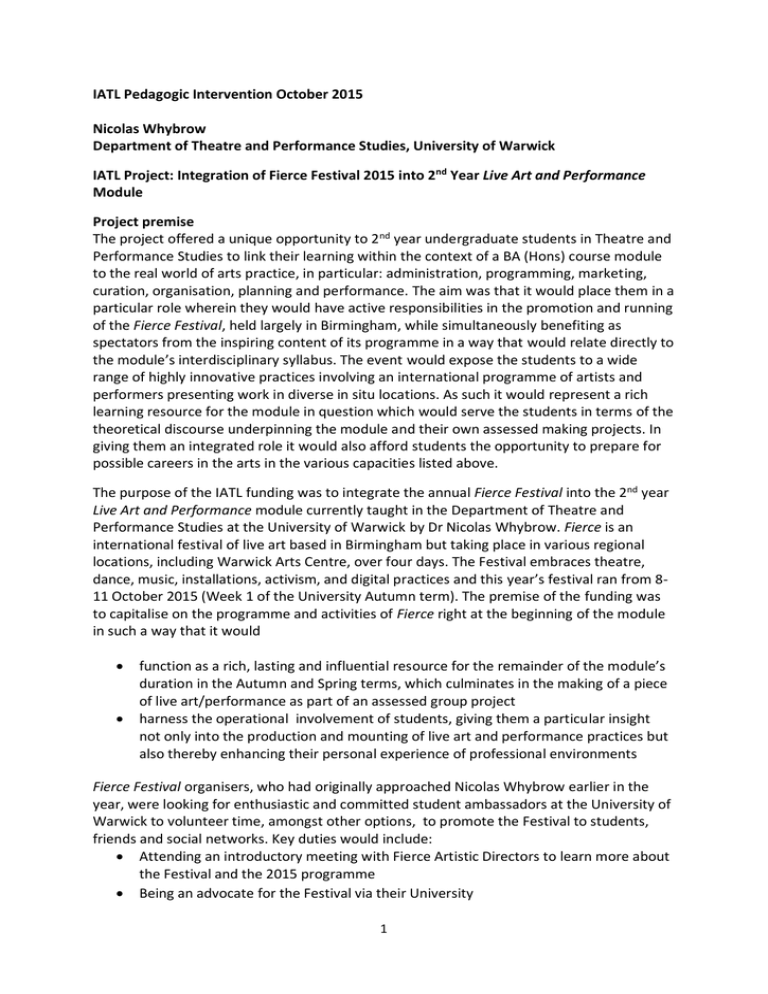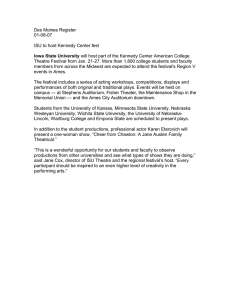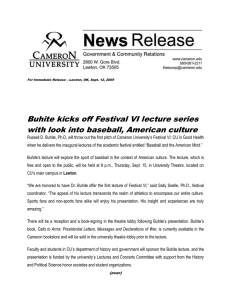IATL Pedagogic Intervention October 2015 Nicolas Whybrow
advertisement

IATL Pedagogic Intervention October 2015 Nicolas Whybrow Department of Theatre and Performance Studies, University of Warwick IATL Project: Integration of Fierce Festival 2015 into 2nd Year Live Art and Performance Module Project premise The project offered a unique opportunity to 2nd year undergraduate students in Theatre and Performance Studies to link their learning within the context of a BA (Hons) course module to the real world of arts practice, in particular: administration, programming, marketing, curation, organisation, planning and performance. The aim was that it would place them in a particular role wherein they would have active responsibilities in the promotion and running of the Fierce Festival, held largely in Birmingham, while simultaneously benefiting as spectators from the inspiring content of its programme in a way that would relate directly to the module’s interdisciplinary syllabus. The event would expose the students to a wide range of highly innovative practices involving an international programme of artists and performers presenting work in diverse in situ locations. As such it would represent a rich learning resource for the module in question which would serve the students in terms of the theoretical discourse underpinning the module and their own assessed making projects. In giving them an integrated role it would also afford students the opportunity to prepare for possible careers in the arts in the various capacities listed above. The purpose of the IATL funding was to integrate the annual Fierce Festival into the 2nd year Live Art and Performance module currently taught in the Department of Theatre and Performance Studies at the University of Warwick by Dr Nicolas Whybrow. Fierce is an international festival of live art based in Birmingham but taking place in various regional locations, including Warwick Arts Centre, over four days. The Festival embraces theatre, dance, music, installations, activism, and digital practices and this year’s festival ran from 811 October 2015 (Week 1 of the University Autumn term). The premise of the funding was to capitalise on the programme and activities of Fierce right at the beginning of the module in such a way that it would function as a rich, lasting and influential resource for the remainder of the module’s duration in the Autumn and Spring terms, which culminates in the making of a piece of live art/performance as part of an assessed group project harness the operational involvement of students, giving them a particular insight not only into the production and mounting of live art and performance practices but also thereby enhancing their personal experience of professional environments Fierce Festival organisers, who had originally approached Nicolas Whybrow earlier in the year, were looking for enthusiastic and committed student ambassadors at the University of Warwick to volunteer time, amongst other options, to promote the Festival to students, friends and social networks. Key duties would include: Attending an introductory meeting with Fierce Artistic Directors to learn more about the Festival and the 2015 programme Being an advocate for the Festival via their University 1 Posting news, information and images on social networking sites including student related pages and groups on Facebook and Twitter Sourcing opportunities in student media Promoting the festival at student events Maintaining regular contact with the Fierce artistic directors to keep up to date with the Festival programme and feedback on successful promotions Nicolas Whybrow had a preliminary meeting in person with Fierce director Harun Morrison and assistant producer Ria Jones to discuss these terms. The artistic directors agreed to do a free introductory session with the Live Art and Performance students in May/June 2015 as well as a post-event insight and debrief session in October (for which a fee of £100 was suggested). The first session would frame the students for the Festival in terms both of its thematic/conceptual/curatorial concerns and the part they would be able to play in its running, while the second session would reflect on the experience as a major arts event in itself and from the perspective of the students’ involvement. The module is capped at 16 students so the bulk of the costs would go towards the ‘see-everything’ passes (16 x £50 = £800) and subsidised travel to locations (in Birmingham) over three days (16 x 3 x £5 = £240). Projected outcomes for students Work experience, forging contacts and practical skills relevant for student CVs and careers as well as the module in question Reduced-rate ‘see-everything’ pass (£50) for the Fierce Festival 2015 An opportunity to engage with and contribute to the exciting work of Fierce and be a part of one of the year’s most exciting live art festivals Conceptual and practical inspiration for the remainder of the Live Art and Performance module running in the Autumn and Spring Terms 2015/16 Projected timeline June 2015: Induction talk to 2nd year Live Art and Performance module students by a Fierce director. Between June and September 2015 (as appropriate): Contact and briefing of students by Fierce personnel regarding ambassadorial/volunteer roles in lead-up to Festival. 8-11 October 2015: Full participation in all Fierce events and performances, including volunteer roles. 16 October 2015: Follow-up debrief of Festival with module group by Fierce directors. Post-event summary The project was notable for the way it followed almost exactly the pre-set outline detailed above. In June 2015, while the students were still completing their 1st years, co-director Harun Morrison provided an illuminating presentation of Fierce 2015’s curatorial premise, 2 explaining each programmed piece and generally giving students a detailed foretaste of the Festival. This naturally served to whet appetites not only for the Festival itself but for students’ volunteer roles. The group was advised to expect contact from the Festival team from early September onwards when volunteer options would be presented and students could make their minds up about what they might wish to participate in and to what extent. In the summer Fierce appointed a project manager, Toni Lewis, and assistant, Ria Jones, to run the student ambassador dimension of the Festival. As planned they provided a range of participatory options in September and these are detailed in their breadth in Appendix A (pp.5-6 below). Lewis and Jones took charge and negotiated roles directly with all students in the group. Perhaps the most significant involvement by students witnessed three of them auditioning and being accepted to perform in one of the programmed pieces (see option 3). Not only did this give the students the experience of auditioning for, devising and performing a piece of performance with professional artists within the context of an international festival, it also stretched their creative skills inasmuch as it was a dance-based piece and dance does not usually feature as part of their undergraduate curriculum. In acknowledgement of their particular contribution the three students were each paid a flat fee of £50. All three students chose to write about this experience in response to the formal critical review assignment that was to form part of the module assessment (see Appendix B, p.6 below). The latter had not originally been a planned part of the pedagogical intervention, but obviously made sense in the subsequent planning of the module over the course of the academic year as a way of both guaranteeing student commitment and offering an opportunity to students to reflect critically on the experience from a range of possible perspectives. Another student got involved at an earlier stage of Fierce preparations in September. Here she assisted in the running of a site-specific community event with children and parents entitled SLIP at the Old Mosley Baths in Birmingham over the course of a weekend. Again, the rewarding nature of the experience resulted in the student chosing to focus on this event in her critical review. The rest of the group was dispersed between various tasks, covering, in fact, all the ones proposed by Fierce and listed in Appendix A, with some taking on several tasks at once. This included conducting micro-interviews with both artists and visitors for the Fierce website, assisting with get-ins and installations, stewarding and publicity via social media. This form of involvement evidently instilled in students a sense of participation and ownership, a feeling that was transferred in turn to their other role of ‘see-everything’ spectator. Here a high degree of engagement was demanded with over twenty pieces being shown over the course of three days, including one which required a sleep-over with some fifty other Festival participants on a cold concrete gallery (Sleep with a Curator, East Side Galleries). It should not be forgotten that the students had to commute to Birmingham from Leamington each time and, with several events taking place outside of the immediate city centre – at MAC or The Drum, for example – the expected commitment merely to get to venues and performances was considerable. Involvement in and benefit from the Fierce Festival has both short and long term aspects to it. Apart from the immediate participation of students, the material witnessed has already provided ample module content upon which to feed in itself and priceless points of 3 reference in the discussion of other live art and performance work featuring in the syllabus. This is particularly pertinent for live art: the module always runs the risk of fundamentally contradicting one of the central properties of the form, namely its liveness, by having to be over-reliant on accounts of practices or video documentations. Students appear to have gained a far better sense of the significance of both the live and the situated in performance – not least in terms of the ethical positioning of the spectator – as a result of witnessing Fierce and this in turn has given them a better appreciation of other artists studied ‘at a distance’ within the module. This will doubtless continue to play itself out during the course of the module and, above all, when students come to make work themselves in the latter part of the Spring Term 2016. In a long term sense, participation in Fierce has given students an insight into the running of a major arts event – the downs as much as the ups – but it is also something that they can boast about on their CVs. In both regards, this will prepare them in their post-graduation quest to get a foot on the rung of the arts careers ladder. A measure of the extent to which the involvement of the Warwick students was appreciated by the Fierce team was that four members, including both directors Laura McDermott and Harun Morrison, came over specially from Birmingham to the Theatre and Performance Studies Department two weeks after the end of the Festival to conduct a highly illuminating debrief with the students. With the two directors having come to the end of their five-year stint as co-curators in 2015, they explained afterwards that they had regarded the session as an opportunity to conduct a form of internal evaluation for themselves. Subsequent to this meeting, Fierce contacted the Department to offer it curatorship of its archive, which could also be taken as testament to a highly fruitful working relationship. 4 APPENDICES (A + B) A. Fierce Festival 2015 roles for Warwick Live Art and Performance students Fierce homepage weblink: http://wearefierce.org/ 1. Ongoing from Sept (2 students) Fierce Networking: undertaking communication liaison between the Festival and University community using Facebook, Twitter etc (multi-purpose go-between) 2. 7-11 October (2 students) Vlogging: undertaking micro-video interviews with audience/visitors to the Festival at the Birmingham Open Media Hub (BOM HUB next to New Street Station, Fierce Festival HQ – 1 Dudley Street, Birmingham B5 4EG) 3. 9-10 October (2 students) Club Fierce, Gazelle Twin dancers: rehearse and perform on stage in at the Old Print Works. No need to be a trained dancer, just a desire to perform! http://wearefierce.org/events/club-fierce-gazelle-twin/ 4. 24 September (2 students) Of Riders and Running Horses, Still House: assisting with get-in for this site-specific piece at a secret Birmingham location (car park, city centre) which will act as a form of taster for the Festival in the week before it takes place. http://wearefierce.org/events/of-riders-andrunning-horses/ 5. 25-26 September (2 students) Of Riders and Running Horses, Still House: front of house – directing the audience, distributing brochures etc for this site-specific piece at a secret Birmingham location (car park, city centre) which will act as a form of taster for the Festival in the week before it takes place. http://wearefierce.org/events/of-riders-and-running-horses/ 6. 2 October (2 students) Digbeth First Friday: supporting installation and preparation for this event prior to the Festival opening (prepping space, organising bar). Digbeth First Friday is an event that takes place at BOM Hub in Birmingham every first Friday of the month (1 Dudley Street, Birmingham B5 4EG). http://digbethfirstfriday.com/ 7. 6-7 October (2 students) BOM Hub (Fierce Festival HQ – 1 Dudley Street, Birmingham B5 4EG): transform and merchandise stall operations (including prepping space and organising bar). 8. 7-8 October (2 students) Chris Goode’s Weaklings at Warwick Arts Centre: stewarding this show (giving audience directions and info, distributing brochures). http://wearefierce.org/events/weaklings/ 9. 10-11 October (4 students) 5 Club Fierce party: stewarding the Saturday/Sunday Festival club/pub night at the Old Print Works/BOM. 10. 5-12 October (2 students) Culture, Administration and Trembling installation: hands-on assistance with setting up and taking down this installation at a venue in Digbeth, Birmingham. http://wearefierce.org/events/livingstone-lacey-petrin-thompson-culture-administrationtrembling/ 11. Ongoing before and during Festival (2 students) Fierce blog: undertaking interviews with participating artists/performers in the lead up to the Festival as part of the official Fierce blog. B. Fierce Festival critical review assignment brief (25%) UNIVERSITY OF WARWICK DEPARTMENT OF THEATRE AND PERFORMANCE STUDIES Live Art and Performance 2015-16 (BA Hons. Year 2 option) Choose one of the following options as the starting point for a 2,500 word critical review of the Fierce Festival in 2015. The deadline for submission is Thursday 19 November 2015 (Week 7, Autumn Term). 1. Drawing on a range of performances and artworks witnessed at Fierce, present a portfolio of critical reviews that analyse and evaluate how the pieces worked and what they were trying to convey. You may combine two or more performances in one review if there is a sound basis for doing so, and you may also vary the lengths of each review to test your abilities to offer critical insights in both concise and extended forms respectively. 2. Taking into account the impact of the Fierce Festival as a whole, write a critical evaluation of it as a cultural event, paying attention to factors such as that it takes place annually (for a short week), serves a particular region (or audience constituency), occurs in a range of urban locations/venues and offers cutting-edge, non-mainstream live art and performance work. Your review may wish to focus on the Festival’s own stated mission-words: Live Art, Collision, Hyperlocal and Supernow. 3. Given your involvement as volunteer at the Fierce Festival, write an evaluation of your particular experience of it in your allotted role and the way it may have afforded you critical insights into how such a Festival works in general terms (what are its successes and failures in your eyes?). You may wish to set the discussion of this role against or alongside that of your other role as ‘see-everything’ spectator. 6







